30/06/2017
Look the Oil paintings
But then there was the anti-angell.
The first is romantic delacroix. The man nicknamed the romantic lion and worshipped Rubens, so it was the romantic lion pie. The wind blows and the wind blows. He was the first person to touch the brush of his pen to show his colors, heat and power:
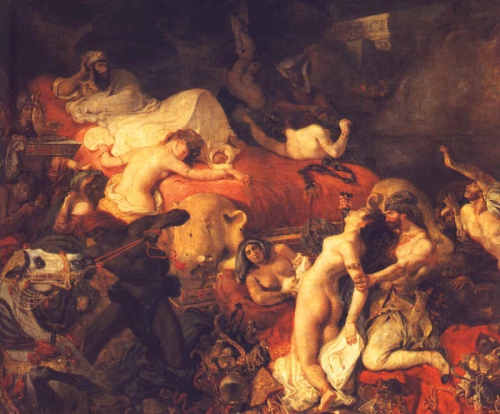
And then there's the courbet. This is more realistic, you have to draw the most everyday things, you don't want to draw things. Such as:
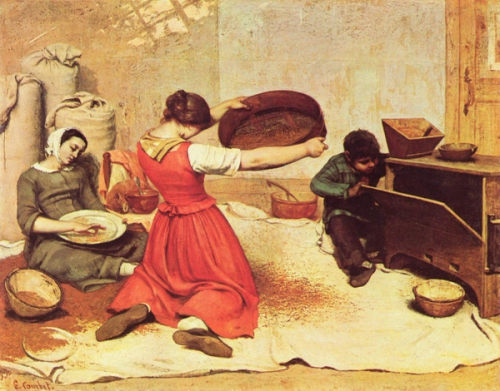
Then, in the 19th century, there were many painters in France who liked to write in the wild, and there was one of the greatest landscape painters of all time. He was able to grasp the dynamics of the scene and paint the fluffy texture of the wind.
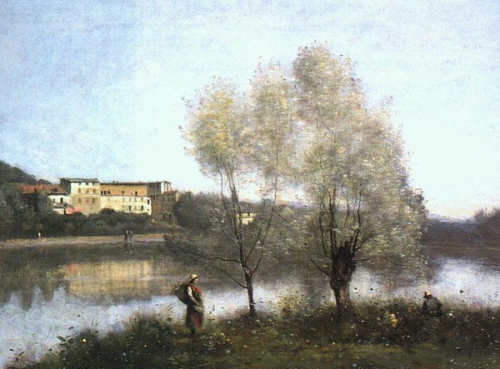
So:
Michael Cheval art
The rebellious spirit of delacroix; Courbet's "painting in front of me" and coro's field of wild sketching are a dynamic blend of spirit.
It became "painting at the scene, grasping the light of a moment, grasping the light".
That's the impressionist monet:
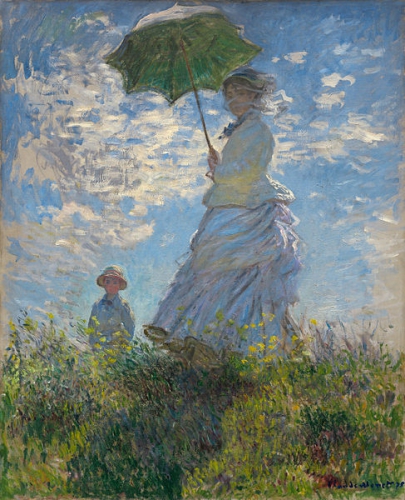
Later, Cezanne further studied, felt that all sketch, actually is the color block. Therefore, he tried to make an article on the material, color and existence of the object, which abandoned the western painting techniques. Let's feel the persistence of Cezanne's color and form:
Vladimir Kush
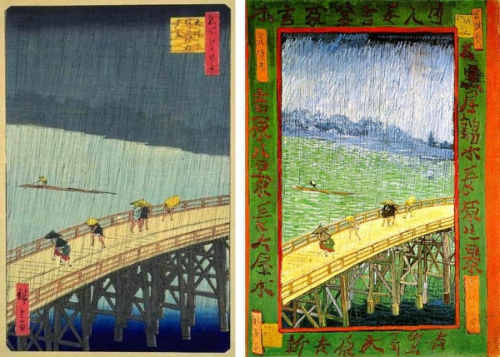
In the end, everyone was influenced by the Japanese floating world, and began to try the orientated perspective. Western oil painting techniques began to integrate with the east, which was later impressionism and the 20th century. Here is van gogh's imitation of the Japanese grand master gochuan.
26
Just a little bit of reasoning.
Master of oil painting is actually all-powerful, but each has its own focus.
So, look at Florence, feel their body composition.
Look at Venice, feel their colour.
Look at caravaggio's pie and feel their shade.
Look at the Dutch and the whole northern school, feel their details and look at them.
Look at the baroque, feel their grand sense of stage.
Look at classicism, feel their dignified and sedate composition and color.
Look at rococo, feel their fine looks and girly figure.
If you look at the new classic, watch the historical drama.
Look at the academy, just look at living sculpture.
Look at romanticism and feel the power boiling.
Look at impressionism, feel the light and feel the power of color to your senses.
Of course, all of these are superficial, just a general idea. It's not enough to think about it, it's not enough -- how many of them have been painted for four or five hundred years, just a few years? But there are some things in the world that know a little bit about how hard they are, aren't they?
03:02 | Lien permanent | Commentaires (0)
09/10/2016
How to Draw Sketch of Characters
Abstract: The mature dynamic sketch technique is the sign of the artist's maturity. Dynamic sketch of the human body requires that the artist not only have a high modeling ability and overall consciousness, but also have a keen sense of ability and proficiency in the use of anatomical knowledge of experience. But we can not say that the dynamic sketch of learning to be placed on the basis of training is completed, on the contrary, we should be in the basic sketch training at the same time dynamic sketch exercises. In Europe, sketches are used as the main form of training means, and now some parts of the country from the child stage began to cultivate the ability of sketches, but also played a very good effect.
Dynamic sketch and static sketches are very different, at any time changes in the object, you can not use repeated observation method to capture the object, can not be prepared in advance method of expression of objects, dynamic sketches rely on dynamic changes in the process of object movement And & quot; selected & quot; for the selected action.
"Selected" is a dynamic sketch-specific technology. Selection refers to the painter's choice of the instantaneous movement of the object, that is, the skater is faced with the free-moving object character, selecting the most dynamic moment in the object's series of actions. The choice of dynamic sketch action in line with the two conditions, one is the selected action to be "styling"; the other is dynamic to have a sense of beauty, two conditions are indispensable. For example, when we choose a person running, to select the most able to reflect the speed, strength and vigorous meaning of the dynamic, that is, the largest leg span, arms swing the largest dynamic, if we choose the hands and feet overlap Dynamic, after drawing the effect will be like walking instead of running.
It is also important to select the sensation and memory of the dynamics, which is a one-time process, rather than being repeated as many times as the sketch. Such a one-time memory must be sensible, and if we lose the memory of sensibility, the action we draw may flow in the formulating and conceptualizing. Only by virtue of the specific action of feelings of particularity, supplemented by knowledge of human anatomy of the knowledge we have the possibility to draw such as crazy run or leisurely run, etc. to avoid similar works. In practice, we only rely on an instant observation to complete a specific dynamic sketch works is unthinkable. We must rely on the general experience of this particular action and related knowledge to add, in order to complete the work.
In the dynamic sketch training to achieve the above requirements, we must learn to "catch" and the performance of "dynamic line." Dynamic line is the main line of the performance characteristics of the human body. Dynamic lines generally manifested in the human body movements in the relationship between the volume change. When the character side, the dynamic line is often reflected in the outline of the side; when the characters positive, the dynamic line will highlight the changes in the spine and limbs. Seizing the dynamic line is crucial to good dynamic sketching. How to draw a good dynamic line? We should note the following aspects:
(1) the dynamic line is generated by changes in human action, it is the most obvious shape, clothing and body parts are more tightly affixed.
(2) draw dynamic line, to seize the big parts, grasping the key dynamics and attention to the dynamic center of gravity.
(3) dynamic line is very simple lines, according to the complexity of the action to determine the number of dynamic lines, in each action, the main dynamic line only one, the other is the dynamic auxiliary line.
(4) to seize the various key parts of the human body structure, such as the head and shoulder, arm and trunk, pelvis and leg, thigh and calf joints and leg and foot junction.
Dynamic sketch drawing steps are:
(1) careful observation of dynamic objects, selected typical dynamic, focused, fully intact feel dynamic characteristics.
(2) quickly draw the main dynamic line and dynamic line.
(3) by observation or memory to draw the volume relationship.
(4) quickly draw the performance of the momentum of the clothing lines.
(5) with the observation and anatomical knowledge to fill the details.
(6) in accordance with the screen structure requirements to adjust the form of rhythm.
(7) depicts the completion of the head.
As a beginner, it is difficult to start drawing dynamic sketches. Beginners in the beginning to draw dynamic sketches can choose to repeat the strong dynamic objects to practice, such as see-saw, shovel soil, etc., to be skilled accumulation of experience, such as dance, sports, dynamic exercises. Dynamic sketching is a need to pay a great effort and professionalism training courses, only the perennial unremitting hard training, in order to cultivate the hard work of dynamic sketches for the future to create a good work of art to lay a solid foundation. The familiar dynamic sketching technique is a sign of the artist's maturity. Dynamic sketch of the human body requires that the artist not only have a high modeling ability and overall consciousness, but also have a keen sense of ability and proficiency in the use of anatomical knowledge of experience. But we can not say that the dynamic sketch of learning to be placed on the basis of training is completed, on the contrary, we should be in the basic sketch training at the same time dynamic sketch exercises. In Europe, sketches are used as the main form of training means, and now some parts of the country from the child stage began to cultivate the ability of sketches, but also played a very good effect.
Dynamic sketch and static sketches are very different, at any time changes in the object, you can not use repeated observation method to capture the object, can not be prepared in advance method of expression of objects, dynamic sketches rely on dynamic changes in the process of object movement And & quot; selected & quot; for the selected action.
"Selected" is a dynamic sketch-specific technology. Selection refers to the painter's choice of the instantaneous movement of the object, that is, the skater is faced with the free-moving object, selecting the most dynamic moment in the object's series of actions. The choice of dynamic sketch action in line with the two conditions, one is the selected action to be "styling"; the other is dynamic to have a sense of beauty, two conditions are indispensable. For example, when we choose a person running, to select the most able to reflect the speed, strength and vigorous meaning of the dynamic, that is, the largest leg span, arm swing the largest dynamic, if we choose the hands and feet overlap Dynamic, after drawing the effect will be like walking instead of running.
It is also important to select the sensation and memory of the dynamics, which is a one-time process, rather than repeated as many times as the sketch. Such a one-time memory must be sensible, and if we lose the memory of sensibility, the action we draw may be in the formulating and conceptualizing. Only by virtue of the specific action of feelings of particularity, supplemented by knowledge of human anatomy of the knowledge we have the possibility to draw such as crazy run or leisurely run, etc. to avoid similar works. In practice, we only rely on an instant observation to complete a specific dynamic sketch works is unthinkable. We must rely on the general experience of this particular action and related knowledge to add, in order to complete the work.
In the dynamic sketch training to achieve the above requirements, we must learn to "catch" and the performance of "dynamic line." Dynamic line is the main line of the performance characteristics of the human body. Dynamic lines generally manifested in the human body movements in the relationship between the volume change. When the character side, the dynamic line is often reflected in the outline of the side; when the characters positive, the dynamic line will highlight the changes in the spine and limbs. Seizing the dynamic line is crucial to good dynamic sketching. How to draw a good dynamic line? We should note the following aspects:
(1) the dynamic line is generated by changes in human action, it is the most obvious shape, clothing and body parts are more tightly affixed.
(2) draw dynamic line, to seize the big parts, grasping the key dynamics and attention to the dynamic center of gravity.
(3) dynamic line is very simple lines, according to the complexity of the action to determine the number of dynamic lines, in each action, the main dynamic line only one, the other is the dynamic auxiliary line.
(4) to seize the various key parts of the human body structure, such as head and shoulder, arm and trunk, pelvis and leg, thigh and calf joints and leg and foot junction.
Dynamic sketch drawing steps are:
(1) careful observation of dynamic objects, selected typical dynamic, focused, full and complete experience of dynamic features.
Onelio Marrero Painting for sale
(2) quickly draw the main dynamic line and dynamic line.
(3) by observation or memory to draw the volume relationship.
(4) quickly draw the performance of the momentum of the clothing lines.
(5) with the observation and anatomical knowledge to fill the details.
(6) in accordance with the screen structure requirements to adjust the form of rhythm.
(7) depicts the completion of the head.
As a beginner, it is difficult to start drawing dynamic sketches. Beginners in the beginning to draw dynamic sketches can choose to repeat the strong dynamic objects to practice, such as see-saw, shovel soil, etc., to be skilled accumulation of experience, such as dance, sports, dynamic exercises. Dynamic sketch is a need to pay a great effort and professionalism training courses, only perennial unremitting hard training, in order to train a dynamic sketch.
11:16 | Lien permanent | Commentaires (0)
17/07/2016
Raymond Leech, East Anglian Vettriano
Je suis récemment tombé sur des images de Raymond Leech (1949 -) peintures. Comme cette notice biographique indique, Leech est basée à East Anglia en Angleterre et peint des scènes côtières, dont certains se trouvent au lien.
Mais d'autres peintures Leech moi de ceux qui rappellent fortement par son contemporain écossais Jack Vettriano (1951 -) ... Wikipedia entrée ici.
Ce que nous avons sont fumants (à des degrés divers) scènes mettant en vedette belles, les femmes sont souvent pas entièrement vêtus et des hommes portant généralement des bretelles (bretelles, au Royaume-Uni) et souvent avec des chapeaux. Je ne sais pas assez sur Leech pour dire s'il suit l'exemple de Vettriano ou il y a eu d'abord.
Quant au style, Vettriano peint dans un, simplifié, style presque-affiche légèrement plat alors Leech est plus «painterly», où traçages sont en vedette. Voici quelques exemples de Vettiano suivis par une partie du travail de Leech.
Gallery
Vettriano paintings for sale
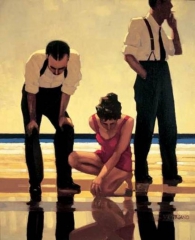
Narcissistic Bathers
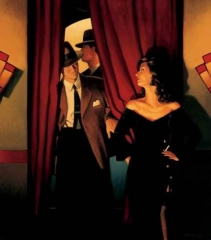
The Purple Cat
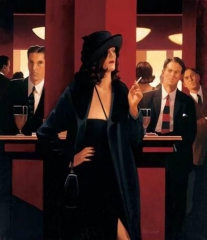
Games of Power
Leech
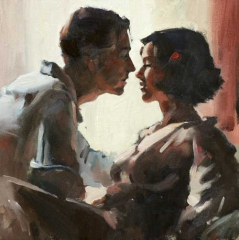
Couple about to kiss
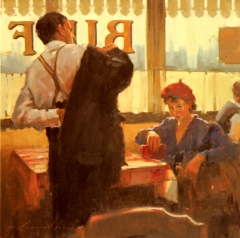
A Brief Encounter

An especially Vettriano-like painting.
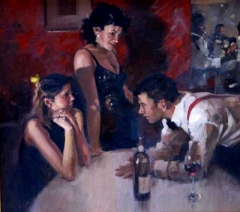
Nightclub scene
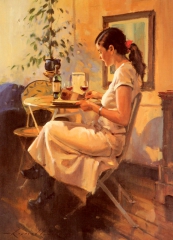
Sunday Girl
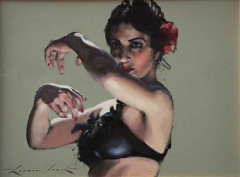
Dancer (one of a series with same model)
09:35 | Lien permanent | Commentaires (0)